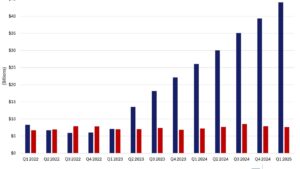Last month, we posted a detailed writeup on Royal Caribbean Cruises Ltd (Ticker: RCL) on SumZero. That writeup was then published in Barron’s under the title:Royal Caribbean Stock Can Gain Nearly 40%: Portfolio Manager. In both cases, readers chimed in with concerns about the free cash flow at the company. One pointed to the increase in debt and cumulative negative free cash flow over the past 20 years. The other noted the high capital intensity of the cruise industry and questioned the weak free cash flow. We acknowledge that cruise ships are expensive assets, and thought the issue warranted a thorough discussion.
How Much Does History Matter:
We have to admit that we haven’t looked at free cash flow going back to the ’90s. More recently, free cash flow has been positive in every year since 2011 with the exception of 2018 when it was slightly negative. The reason for the small negative free cash flow that year was a massive $3.7B cap-x bill related to new ships. It’s worth pointing out that free cash flow the year before that was over $2.5B due to a lack of ship delivery that year. That’s almost $12 a share of free cash flow. In 2011, RCL had 22 ships. The company has grown that to 63 ships with positive free cash flow in 7 out of those 8 years.
That leaves us with the question of whether it’s worthwhile for RCL to grow by adding new ships. With cruise pricing at record highs, and ships sailing at well over 100% full, we think the company is doing the right thing by building new ships and continuing to grow. While we acknowledge RCL has debt on the balance sheet, based on debt/equity, debt/EBITDA, and interest coverage, we don’t think the company is over-leveraged.
An Alternative View of Free Cash Flow:
Free cash flow in any given year is going to depend heavily on the ship delivery schedule. Imagine a situation where the delivery of a ship is delayed from December of one year to January of the next. While the delay might only be a few days, that could shift free cash flow up by $1.5 billion in the first year and down by the same amount the following year. As a result, we think there’s value in an alternative way of viewing free cash flow. If we take cash flow from operations, subtract capital expenditures, and add back the 1 year expected ship purchase obligations from the prior year, we can get a measure of what the cash flow of the company is excluding new ship purchase. While we want Royal Caribbean to invest in growing its fleet, using this measure, we can see what the free cash flow would be over time if the company didn’t invest in building new ships. That was $1.7B in 2016, $2.6B in 2017, and $2.2B in 2018. With 210MM shares outstanding, that’s a lot of cash flow from existing operation (again – with no new ships).
Conclusion:
We see RCL producing dramatically higher returns on invested capital while showing positive free cash flow. The debt load isn’t onerous given the high interest coverage, and adjusting for new ship delivery, RCL is producing over $10 a share in free cash flow. Our thanks to smart readers asking important questions. We’re always happy to engage on these key issues.



